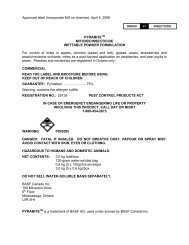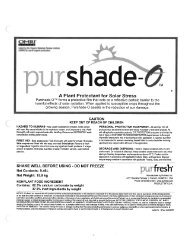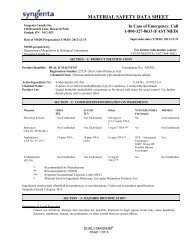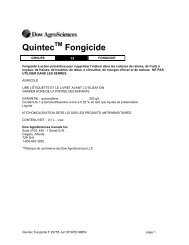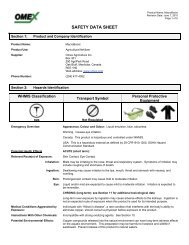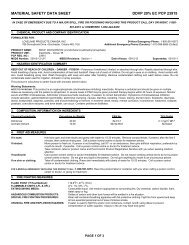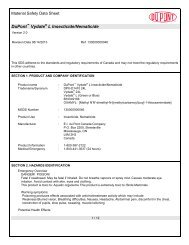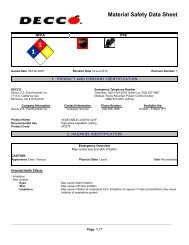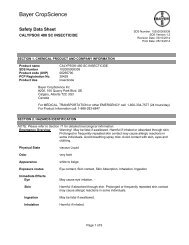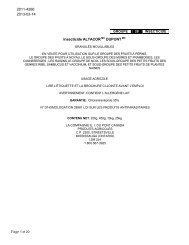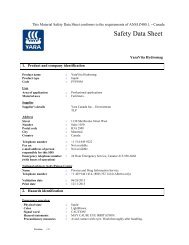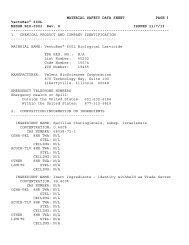Phosyn Seniphos msds english.pdf - Bartlett.ca
Phosyn Seniphos msds english.pdf - Bartlett.ca
Phosyn Seniphos msds english.pdf - Bartlett.ca
- No tags were found...
You also want an ePaper? Increase the reach of your titles
YUMPU automatically turns print PDFs into web optimized ePapers that Google loves.
YaraVita <strong>Seniphos</strong>ventilation. Do not get in eyes. Do not get on skin. Keep container tightlyclosed. Wash thoroughly after handling.Potential acute health effectsInhalation : May give off gas, vapor or dust that is very irritating or corrosive to therespiratory system. Exposure to decomposition products may <strong>ca</strong>use ahealth hazard. Serious effects may be delayed following exposure. Vaporis strongly irritating to the eyes and respiratory system.Ingestion : Toxic if swallowed. May <strong>ca</strong>use burns to mouth, throat and stomach.Skin : Corrosive to the skin. Causes burns.Eyes : Corrosive to eyes. Causes burns.Potential chronic health effectsChronic effects : No known signifi<strong>ca</strong>nt effects or criti<strong>ca</strong>l hazards.Carcinogenicity : No known signifi<strong>ca</strong>nt effects or criti<strong>ca</strong>l hazards.Mutagenicity : No known signifi<strong>ca</strong>nt effects or criti<strong>ca</strong>l hazards.Teratogenicity : No known signifi<strong>ca</strong>nt effects or criti<strong>ca</strong>l hazards.Developmental effects : No known signifi<strong>ca</strong>nt effects or criti<strong>ca</strong>l hazards.Fertility effects : No known signifi<strong>ca</strong>nt effects or criti<strong>ca</strong>l hazards.Target organs : Not available.Medi<strong>ca</strong>l conditionsaggravated by over-exposure: None known.See toxicologi<strong>ca</strong>l information (section 11)3. Composition/information on ingredientsName CAS number %Phosphoric acid, <strong>ca</strong>lcium salt (2:1), monohydrate 10031-30-8 15 - 20Phosphoric acid 7664-38-2 10 - 12,5Nitric acid, <strong>ca</strong>lcium salt (2:1) 13477-34-4 7 - 10There are no additional ingredients present which, within the current knowledge of the supplier and in theconcentrations appli<strong>ca</strong>ble, are classified as hazardous to health or the environment and hence requirereporting in this section.4. First aid measuresEye contact : Immediately flush eyes with plenty of water for at least 15 minutes,keeping eyelids open. Check for and remove any contact lenses. Getmedi<strong>ca</strong>l attention immediately. Chemi<strong>ca</strong>l burns must be treated promptlyby a physician.Skin contact : Wash with soap and water. Get medi<strong>ca</strong>l attention if irritation develops.Inhalation : Avoid inhalation of vapor, spray or mist. If inhaled, remove to fresh air.Get medi<strong>ca</strong>l attention if symptoms occur.Ingestion : Wash out mouth with water. If material has been swallowed and theexposed person is conscious, give small quantities of water to drink. Donot induce vomiting unless directed to do so by medi<strong>ca</strong>l personnel. Getmedi<strong>ca</strong>l attention immediately.Protection of first-aiders : No action shall be taken involving any personal risk or without suitabletraining. If it is suspected that fumes are still present, the rescuer shouldwear an appropriate mask or self-contained breathing apparatus. It maybe dangerous to the person providing aid to give mouth-to-mouthresuscitation. Wash contaminated clothing thoroughly with water beforeDate of issue : 06/26/2013Page:2/12
YaraVita <strong>Seniphos</strong>removing it, or wear gloves.Notes to physician : Treat symptomati<strong>ca</strong>lly. Contact poison treatment specialist immediatelyif large quantities have been ingested or inhaled. In <strong>ca</strong>se of inhalation ofdecomposition products in a fire, symptoms may be delayed. Theexposed person may need to be kept under medi<strong>ca</strong>l surveillance for 48hours.5. Fire-fighting measuresFlammability of the product : In a fire or if heated, a pressure increase will occur and the container mayburst.Extinguishing mediaSuitable : Use an extinguishing agent suitable for the surrounding fire.Not suitable : None identified.Special exposure hazards : Promptly isolate the scene by removing all persons from the vicinity ofthe incident if there is a fire. No action shall be taken involving anypersonal risk or without suitable training.Hazardous thermaldecomposition productsSpecial protective equipmentfor fire-fightersSpecial remarks on firehazardsSpecial remarks on explosionhazards: Decomposition products may include the following materials:nitrogen oxidesphosphorus oxidesmetal oxide/oxidesAvoid breathing dusts, vapors or fumes from burning materials.In <strong>ca</strong>se of inhalation of decomposition products in a fire, symptoms maybe delayed.: Fire-fighters should wear appropriate protective equipment and selfcontainedbreathing apparatus (SCBA) with a full face-piece operated inpositive pressure mode.: Non-flammable.: None.6. Accidental release measuresPersonal pre<strong>ca</strong>utions : No action shall be taken involving any personal risk or without suitabletraining. Evacuate surrounding areas. Keep unnecessary and unprotectedpersonnel from entering. Do not touch or walk through spilled material.Do not breathe vapor or mist. Provide adequate ventilation. Wearappropriate respirator when ventilation is inadequate. Put on appropriatepersonal protective equipment (see Section 8).Environmental pre<strong>ca</strong>utions : Avoid dispersal of spilled material and runoff and contact with soil,waterways, drains and sewers. Inform the relevant authorities if theproduct has <strong>ca</strong>used environmental pollution (sewers, waterways, soil orair).Methods for cleaning upSmall spill : Stop leak if without risk. Move containers from spill area. Dilute withwater and mop up if water-soluble. Alternatively, or if water-insoluble,absorb with an inert dry material and place in an appropriate wastedisposal container. Dispose of via a licensed waste disposal contractor.Large spill : Stop leak if without risk. Move containers from spill area. Approachrelease from upwind. Prevent entry into sewers, water courses, basementsor confined areas. Wash spillages into an effluent treatment plant orDate of issue : 06/26/2013Page:3/12
YaraVita <strong>Seniphos</strong>proceed as follows. Contain and collect spillage with non-combustible,absorbent material e.g. sand, earth, vermiculite or diatomaceous earth andplace in container for disposal according to lo<strong>ca</strong>l regulations (see section13). The spilled material may be neutralized with sodium <strong>ca</strong>rbonate,sodium bi<strong>ca</strong>rbonate or sodium hydroxide. Dispose of via a licensed wastedisposal contractor. Contaminated absorbent material may pose the samehazard as the spilled product. Note: see section 1 for emergency contactinformation and section 13 for waste disposal.7. Handling and storageHandling : Put on appropriate personal protective equipment (see Section 8). Eating,drinking and smoking should be prohibited in areas where this material ishandled, stored and processed. Workers should wash hands and facebefore eating, drinking and smoking. Remove contaminated clothing andprotective equipment before entering eating areas. Do not get in eyes oron skin or clothing. Do not breathe vapor or mist. Do not ingest. If duringnormal use the material presents a respiratory hazard, use only withadequate ventilation or wear appropriate respirator. Keep in the originalcontainer or an approved alternative made from a compatible material,kept tightly closed when not in use. Keep away from alkalis. Emptycontainers retain product residue and <strong>ca</strong>n be hazardous. Do not reusecontainer. See also Section 8 for additional information on hygienemeasures.Storage : Store in accordance with lo<strong>ca</strong>l regulations. Store in original containerprotected from direct sunlight in a dry, cool and well-ventilated area,away from incompatible materials (see section 10) and food and drink.Separate from alkalis. Keep container tightly closed and sealed untilready for use. Containers that have been opened must be <strong>ca</strong>refullyresealed and kept upright to prevent leakage. Do not store in unlabeledcontainers. Use appropriate containment to avoid environmentalcontamination.8. Exposure controls/personal protectionOccupational exposure limitsIngredientPhosphoric acidDate of issue : 06/26/2013Exposure limitsCA Alberta Provincial (2009-07-01) Notes: Occupational exposure limit isbased on irritation effects and its adjustment to compensate for unusualwork schedules is not required.15-minute occupational exposure limit 3 mg/m3CA Alberta Provincial (2004-04-30) Notes: Occupational exposure limit isbased on irritation effects and its adjustment to compensate for unusualwork schedules is not required.8-hour Occupational exposure limit 1 mg/m3CA British Columbia Provincial (2004-08-01) 8-hour time weightedaverage 1 mg/m3CA British Columbia Provincial (2004-08-01) short-term exposure limit 3mg/m3CA Ontario Provincial (1994-09-01) time-weighted average exposurevalue 1 mg/m3CA Ontario Provincial (1994-09-01) short-term exposure value 3 mg/m3CA Quebec Provincial (2000-01-12) Time Weighted Average (TWA) 1mg/m3CA Quebec Provincial (2000-01-12) Short Term Exposure Limit (STEL) 3Page:4/12
YaraVita <strong>Seniphos</strong>mg/m3Consult lo<strong>ca</strong>l authorities for acceptable exposure limits.Recommended monitoringprocedures: If this product contains ingredients with exposure limits, personal,workplace atmosphere or biologi<strong>ca</strong>l monitoring may be required todetermine the effectiveness of the ventilation or other control measuresand/or the necessity to use respiratory protective equipment. Referenceshould be made to appropriate monitoring standards. Reference tonational guidance documents for methods for the determination ofhazardous substances will also be required.Engineering measures : If user operations generate dust, fumes, gas, vapor or mist, use processenclosures, lo<strong>ca</strong>l exhaust ventilation or other engineering controls to keepworker exposure to airborne contaminants below any recommended orstatutory limits.Hygiene measures : Wash hands, forearms and face thoroughly after handling chemi<strong>ca</strong>lproducts, before eating, smoking and using the lavatory and at the end ofthe working period. Wash contaminated clothing before reusing. Awashing facility or water for eye and skin cleaning purposes should bepresent.Personal protectionRespiratory : Use a properly fitted, air-purifying or air-fed respirator complying withan approved standard if a risk assessment indi<strong>ca</strong>tes this is necessary.Respirator selection must be based on known or anticipated exposurelevels, the hazards of the product and the safe working limits of theselected respirator. Recommended: In <strong>ca</strong>se of inadequate ventilation wearrespiratory protection. acid gas filter (Type E)Hands : Chemi<strong>ca</strong>l-resistant, impervious gloves complying with an approvedstandard should be worn at all times when handling chemi<strong>ca</strong>l products ifa risk assessment indi<strong>ca</strong>tes this is necessary.> 8 hours (breakthrough time): Protective gloves should be worn undernormal conditions of use.Eyes : Safety eyewear complying with an approved standard should be usedwhen a risk assessment indi<strong>ca</strong>tes this is necessary to avoid exposure toliquid splashes, mists or dusts. chemi<strong>ca</strong>l splash goggles and/or faceshield. If inhalation hazards exist, a full-face respirator may be requiredinstead. Recommended: Tightly-fitting gogglesSkin : Personal protective equipment for the body should be selected based onthe task being performed and the risks involved and should be approvedby a specialist before handling this product.Environmental exposurecontrols9. Physi<strong>ca</strong>l and chemi<strong>ca</strong>l propertiesPhysi<strong>ca</strong>l state : liquidFlash point : Not determined.Burning time : Not determined.Burning rate : Not determined.Auto-ignition temperature : Not determined.Flammable limits : Lower: Not determined.: Emissions from ventilation or work process equipment should bechecked to ensure they comply with the requirements of environmentalprotection legislation. In some <strong>ca</strong>ses, fume scrubbers, filters orengineering modifi<strong>ca</strong>tions to the process equipment will be necessary toreduce emissions to acceptable levels.Date of issue : 06/26/2013Page:5/12
YaraVita <strong>Seniphos</strong>Upper: Not determined.Explosive properties : None.Oxidizing properties : None.Color : Green.Odor : Not determined.pH : 1,1Boiling/condensation point : Not determined.Sublimation temperature : Not determined.Melting/freezing point : -15 °C (5 °F)Relative density : 1,312Vapor pressure : Not determined.Odor threshold : Not determined.Evaporation rate : Not determined.Viscosity : Dynamic: < 100 mPa.s: Kinematic: Not determined.Solubility : Not determined.10. Stability and reactivityChemi<strong>ca</strong>l stability : The product is stable.Conditions to avoid : Avoid contamination by any source including metals, dust and organicmaterials.Incompatible materials : Attacks many metals producing extremely flammable hydrogen gaswhich <strong>ca</strong>n form explosive mixtures with air.Reactive or incompatible with the following materials:alkaliscombustible materialsreducing materialsorganic materialsacidsHazardous decomposition : Under normal conditions of storage and use, hazardous decompositionproductsPossibility of hazardousreactions11. Toxicologi<strong>ca</strong>l informationInformation on toxicologi<strong>ca</strong>l effectsAcute toxicityproducts should not be produced.: Under normal conditions of storage and use, hazardous reactions will notoccur.Product / Result Species Dose Exposure ReferencesingredientnamePhosphoric acid, <strong>ca</strong>lcium salt (2:1), monohydrateLD50 Oral Rat 17.500 mg/kg - GTPZAB31(12),53,1987LD50 Oral Rat 3.986 mg/kg - IUCLID 5LD50 Dermal Rabbit > 2.000 mg/kg - IUCLID 5Date of issue : 06/26/2013Page:6/12
YaraVita <strong>Seniphos</strong>Phosphoric acidLD50 Oral Rat 2.600 mg/kg 423 Acute - IUCLID5Oral toxicity - AcuteToxic Class MethodNitric acid, <strong>ca</strong>lcium salt (2:1)LD50 Oral Rat 500 mg/kg 423 Acute - IUCLID 5Oral toxicity - AcuteToxic Class MethodLD50 Dermal Rat > 2.000 mg/kg OECD - IUCLID 5402Conclusion/Summary : No known signifi<strong>ca</strong>nt effects or criti<strong>ca</strong>l hazards.Chronic toxicityProduct / ingredient Result Species Dose Exposure ReferencesnamePhosphoric acid Sub-chronic Rat 250 mg/kg OECD 422 54 days IUCLID5NOAEL OralNitric acid, <strong>ca</strong>lcium Sub-acute Rat > 1000 mg/kg OECD 28 days IUCLID 5salt (2:1)NOAEL Oral407Conclusion/Summary : No known signifi<strong>ca</strong>nt effects or criti<strong>ca</strong>l hazards.Irritation/CorrosionProduct /ingredientnamePhosphoric acid,<strong>ca</strong>lcium salt(2:1),monohydrateNitric acid,<strong>ca</strong>lcium salt(2:1)Result Species Score Exposure Observation ReferencesEyes - Severeirritant OECD405Eyes - Corrosive.OECD 405Rabbit - IUCLID 5Rabbit 4 72 h - IUCLID 5Conclusion/SummarySkin : Corrosive to the skin.Eyes : Causes serious eye damage.Respiratory : May be irritating to the respiratory system.SensitizationConclusion/SummarySkin : No data available for this end-point, hence this classifi<strong>ca</strong>tion is notconsidered to be appli<strong>ca</strong>ble.Respiratory : No data available for this end-point, hence this classifi<strong>ca</strong>tion is notconsidered to be appli<strong>ca</strong>ble.CarcinogenicityConclusion/Summary : No known signifi<strong>ca</strong>nt effects or criti<strong>ca</strong>l hazards.MutagenicityConclusion/Summary : No known signifi<strong>ca</strong>nt effects or criti<strong>ca</strong>l hazards.TeratogenicityConclusion/Summary : No known signifi<strong>ca</strong>nt effects or criti<strong>ca</strong>l hazards.Reproductive toxicityProduct / ingredient Maternal Fertility Development Species Dose Exposure ReferencesDate of issue : 06/26/2013Page:7/12
YaraVita <strong>Seniphos</strong>name toxicity toxinPhosphoric acid - Negative - Rat Oral: > 500mg/kgbw/dayNegative - Negative Rat Oral: > 410mg/kgbw/dayNegative - Negative Mouse Oral: > 370mg/kgbw/dayNitric acid, <strong>ca</strong>lcium - Negative Negative Rat Oral: >salt (2:1)1500mg/kgbw/dayConclusion/Summary : No known signifi<strong>ca</strong>nt effects or criti<strong>ca</strong>l hazards.54 days IUCLID510 days IUCLID510 days IUCLID528 days IUCLID 5IDLH : No data available.12.Ecologi<strong>ca</strong>l informationEcotoxicity : No known signifi<strong>ca</strong>nt effects or criti<strong>ca</strong>l hazards.Aquatic ecotoxicityProduct / ingredientnamePhosphoric acidResult Species Exposure ReferencesAcute EC50 > 100 mg/lFresh water OECD 202Acute EC50 > 100 mg/lFresh water OECD 201Nitric acid, <strong>ca</strong>lcium salt (2:1)Acute LC50 1.378 mg/lFresh water OECD 203Acute EC50 490 mg/lFresh waterAcute EC50 > 1.700mg/l Salt waterAquaticinvertebrates. -DaphniaAquatic plants -Heterosigmaakashiwo48 h IUCLID572 h IUCLID5Fish - Labeo boga 96 h IUCLID 5Aquaticinvertebrates. -DaphniaAquatic plants -HeterosigmaakashiwoConclusion/Summary : No known signifi<strong>ca</strong>nt effects or criti<strong>ca</strong>l hazards.Persistence/degradabilityConclusion/Summary : No known signifi<strong>ca</strong>nt effects or criti<strong>ca</strong>l hazards.48 h IUCLID 510 d IUCLID 5Partition coefficient: n- : Not available.octanol/waterMobility : Not available.Other adverse effects : No known signifi<strong>ca</strong>nt effects or criti<strong>ca</strong>l hazards.13. Disposal considerationsProductMethods of disposal : The generation of waste should be avoided or minimized whereverpossible. Disposal of this product, solutions and any by-products shouldat all times comply with the requirements of environmental protectionand waste disposal legislation and any regional lo<strong>ca</strong>l authorityDate of issue : 06/26/2013Page:8/12
YaraVita <strong>Seniphos</strong>requirements. Dispose of surplus and non-recyclable products via alicensed waste disposal contractor. Waste should not be disposed ofuntreated to the sewer unless fully compliant with the requirements of allauthorities with jurisdiction. Waste packaging should be recycled.Incineration or landfill should only be considered when recycling is notfeasible. This material and its container must be disposed of in a safeway. Care should be taken when handling emptied containers that havenot been cleaned or rinsed out. Empty containers or liners may retainsome product residues. Avoid dispersal of spilled material and runoff andcontact with soil, waterways, drains and sewers.Disposal should be in accordance with appli<strong>ca</strong>ble regional, national and lo<strong>ca</strong>l laws and regulations.Refer to Section 7: HANDLING AND STORAGE and Section 8: EXPOSURE CONTROLS/PERSONALPROTECTION for additional handling information and protection of employees.14.Transport informationRegulation: UN Class14.1 UN number 326414.2 UN proper shipping name CORROSIVE LIQUID, ACIDIC, INORGANIC, N.O.S.(orthophosphoric acid, )14.3 Transport hazard class(es) 814.4 Packing group III14.5 Environmental hazards No.Additional information: UN ClassEnvironmental hazards : No.Regulation: IMDG14.1 UN number 326414.2 UN proper shipping name CORROSIVE LIQUID, ACIDIC, INORGANIC, N.O.S.(orthophosphoric acid, )14.3 Transport hazard class(es) 814.4 Packing group III14.5 Environmental hazards No.14.6 Additional information : IMDGMarine pollutant: No.IMDG Code Segregation : SG01groupEmergency schedules (EmS) : F-A, S-BRegulation: IATADate of issue : 06/26/2013Page:9/12
YaraVita <strong>Seniphos</strong>14.1 UN number 326414.2 UN proper shipping name Corrosive liquid, acidic, inorganic, n.o.s. (orthophosphoric acid,)14.3 Transport hazard class(es) 814.4 Packing group III14.5 Environmental hazards No.14.6 Additional information : IATAMarine pollutant: No.Passenger and Cargo AircraftQuantity limitation: 5.00 LPackaging instructions : 852Cargo AircraftQuantity limitation: 60.00 LPackaging instructions : 856Regulation: DOT Classifi<strong>ca</strong>tion14.1 UN number 326414.2 UN proper shipping name Corrosive liquid, acidic, inorganic, n.o.s. (orthophosphoric acid,)14.3 Transport hazard class(es) 814.4 Packing group III14.5 Environmental hazards No.14.6 Additional information : DOT Classifi<strong>ca</strong>tionEnvironmental hazards : No.Limited quantity : 0.00Packaging instruction : 203Regulation: TDG Class14.1 UN number 326414.2 UN proper shipping name CORROSIVE LIQUID, ACIDIC, INORGANIC, N.O.S.(orthophosphoric acid, )14.3 Transport hazard class(es) 814.4 Packing group III14.5 Environmental hazards No.14.6 Additional information : TDG ClassEnvironmental hazards : No.Limited quantity : 5Special provisions : 16Special pre<strong>ca</strong>utions for user : Transport within user’s premises: always transport in closed containersthat are upright and secure. Ensure that persons transporting the productknow what to do in the event of an accident or spillage.’IMSBC : Not appli<strong>ca</strong>ble.Date of issue : 06/26/2013Page:10/12
YaraVita <strong>Seniphos</strong>Transport in bulk accordingto Annex II of MARPOL73/78 and the IBC Code: Not available.15.Regulatory informationCanadaWHMIS (Canada) : Class E: Corrosive materialCanadian listsCanadian NPRI : The following components are listed:Phosphoric acid, ammonium salt (1:1)Nitric acid, <strong>ca</strong>lcium salt (2:1)CEPA Toxic substances : None of the components are listed.This product has been classified in accordance with the hazard criteria of the Controlled ProductsRegulations and the MSDS contains all the information required by the Controlled Products Regulations.Remark : To our knowledge no other country or state specific regulations areappli<strong>ca</strong>ble.International listsPhilippines inventory (PICCS): Not determined.New Zealand Inventory of Chemi<strong>ca</strong>ls (NZIoC): All components are listed or exempted.Korea inventory: Not determined.Japan inventory: Not determined.China inventory (IECSC): All components are listed or exempted.Australia inventory (AICS): Not determined.Canada inventory: Not determined.Malaysia Inventory (EHS Register): Not determined.Taiwan inventory (CSNN): Not determined.United States inventory (TSCA 8b): Not determined.EC INVENTORY (EINECS/ELINCS): All components are listed or exempted.16.Other informationLabel requirements : CAUSES EYE AND SKIN BURNS. HARMFUL IF SWALLOWED.Key to abbreviations : ATE = Acute Toxicity EstimateBCF = Bioconcentration Factorbw = Body weightCEPA = Canadian Environmental Protection ActGHS = Globally Harmonized System of Classifi<strong>ca</strong>tion and Labelling of Chemi<strong>ca</strong>lsIDLH = Immediately Dangerous to Life or HealthIBC = Intermediate Bulk ContainerIMDG = International Maritime Dangerous GoodsLogPow = logarithm of the octanol/water partition coefficientMARPOL 73/78 = International Convention for the Prevention of Pollution FromShips, 1973 as modified by the Protocol of 1978. ("Marpol" = marine pollution)NPRI = National Pollutant Release InventoryUN = United NationsReferences : EU REACH IUCLID5 CSR.National Institute for Occupational Safety and Health, U.S. Dept. ofHealth, Edu<strong>ca</strong>tion, and Welfare, Reports and Memoranda Registry ofToxic Effects of Chemi<strong>ca</strong>l Substances.IHS, 4777 Levy Street, St Laurent, Quebec HAR 2P9, Canada.Date of printing : 12/11/2013Date of issue : 06/26/2013Page:11/12
YaraVita <strong>Seniphos</strong>Prepared by : Yara Product Classifi<strong>ca</strong>tions & Regulations.Date of issue : 06/26/2013Date of previous issue : 00/00/0000Version : 1.0|| Indi<strong>ca</strong>tes information that has changed from previously issued version.Notice to readerTo the best of our knowledge, the information contained herein is accurate. However, neither the abovenamedsupplier, nor any of its subsidiaries, assumes any liability whatsoever for the accuracy or completenessof the information contained herein. Final determination of suitability of any material is the soleresponsibility of the user. All materials may present unknown hazards and should be used with <strong>ca</strong>ution.Although certain hazards are described herein, we <strong>ca</strong>nnot guarantee that these are the only hazards thatexist.Date of issue : 06/26/2013Page:12/12



